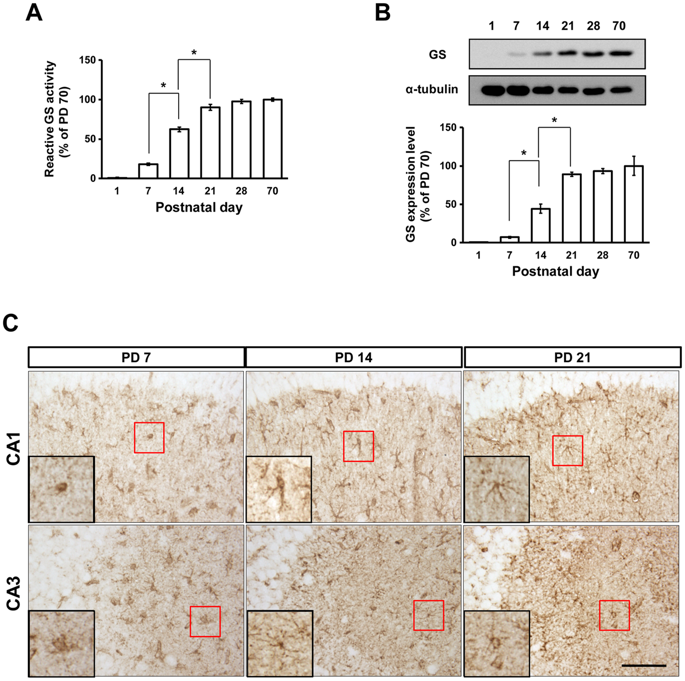Our official English website, www.x-mol.net, welcomes your
feedback! (Note: you will need to create a separate account there.)
Insufficient glutamine synthetase activity during synaptogenesis causes spatial memory impairment in adult mice.
Scientific Reports ( IF 3.8 ) Pub Date : 2019-01-22 , DOI: 10.1038/s41598-018-36619-2 Hyeonwi Son 1 , Sujeong Kim 1 , Doo-Hyuk Jung 1 , Ji Hyeong Baek 1 , Dong Hoon Lee 1 , Gu Seob Roh 1 , Sang Soo Kang 1 , Gyeong Jae Cho 1 , Wan Sung Choi 1 , Dong Kun Lee 2 , Hyun Joon Kim 1
Scientific Reports ( IF 3.8 ) Pub Date : 2019-01-22 , DOI: 10.1038/s41598-018-36619-2 Hyeonwi Son 1 , Sujeong Kim 1 , Doo-Hyuk Jung 1 , Ji Hyeong Baek 1 , Dong Hoon Lee 1 , Gu Seob Roh 1 , Sang Soo Kang 1 , Gyeong Jae Cho 1 , Wan Sung Choi 1 , Dong Kun Lee 2 , Hyun Joon Kim 1
Affiliation

|
Glutamatergic synapses constitute a major excitatory neurotransmission system and are regulated by glutamate/glutamine (Gln) cycling between neurons and astrocytes. Gln synthetase (GS) produced by astrocytes plays an important role in maintaining the cycle. However, the significance of GS during synaptogenesis has not been clarified. GS activity and expression significantly increase from postnatal day (PD) 7 to 21, and GS is expressed prior to glial fibrillary acidic protein (GFAP) and is more abundant than GFAP throughout synaptogenesis. These observations suggest that GS plays an important role in synaptogenesis. We investigated this by inhibiting GS activity in neonatal mice and assessed the consequences in adult animals. Lower expression levels of GS and GFAP were found in the CA3 region of the hippocampus but not in the CA1 region. Moreover, synaptic puncta and glutamatergic neurotransmission were also decreased in CA3. Behaviorally, mice with inhibited GS during synaptogenesis showed spatial memory-related impairment as adults. These results suggest that postnatal GS activity is important for glutamatergic synapse development in CA3.
中文翻译:

突触形成过程中谷氨酰胺合成酶活性不足会导致成年小鼠的空间记忆受损。
谷氨酸能突触构成主要的兴奋性神经传递系统,并受神经元和星形胶质细胞之间谷氨酸/谷氨酰胺(Gln)循环的调节。星形胶质细胞产生的Gln合成酶(GS)在维持周期中起着重要作用。但是,尚不清楚GS在突触发生过程中的意义。从出生后第7天到21天,GS的活性和表达显着增加,并且GS在神经胶质原纤维酸性蛋白(GFAP)之前表达,并且在整个突触发生过程中比GFAP丰富。这些观察结果表明,GS在突触发生中起重要作用。我们通过抑制新生小鼠中的GS活性对此进行了调查,并评估了成年动物的后果。在海马CA3区发现GS和GFAP的表达水平较低,而在CA1区则没有。而且,在CA3中,突触点和谷氨酸能神经传递也降低。行为上,在突触发生过程中受GS抑制的小鼠成年后表现出与空间记忆相关的损伤。这些结果表明,产后GS的活性对于CA3中谷氨酸能突触的发育很重要。
更新日期:2019-01-23
中文翻译:

突触形成过程中谷氨酰胺合成酶活性不足会导致成年小鼠的空间记忆受损。
谷氨酸能突触构成主要的兴奋性神经传递系统,并受神经元和星形胶质细胞之间谷氨酸/谷氨酰胺(Gln)循环的调节。星形胶质细胞产生的Gln合成酶(GS)在维持周期中起着重要作用。但是,尚不清楚GS在突触发生过程中的意义。从出生后第7天到21天,GS的活性和表达显着增加,并且GS在神经胶质原纤维酸性蛋白(GFAP)之前表达,并且在整个突触发生过程中比GFAP丰富。这些观察结果表明,GS在突触发生中起重要作用。我们通过抑制新生小鼠中的GS活性对此进行了调查,并评估了成年动物的后果。在海马CA3区发现GS和GFAP的表达水平较低,而在CA1区则没有。而且,在CA3中,突触点和谷氨酸能神经传递也降低。行为上,在突触发生过程中受GS抑制的小鼠成年后表现出与空间记忆相关的损伤。这些结果表明,产后GS的活性对于CA3中谷氨酸能突触的发育很重要。















































 京公网安备 11010802027423号
京公网安备 11010802027423号